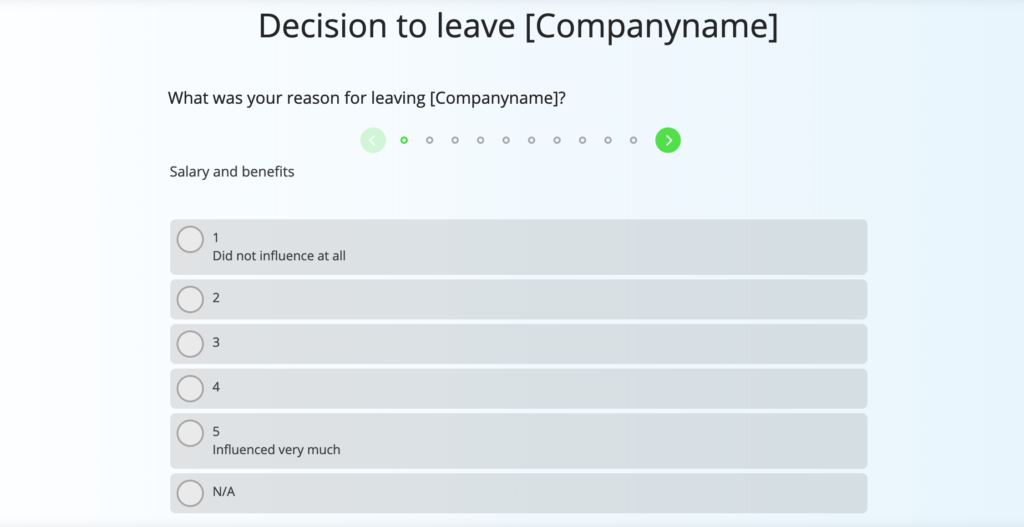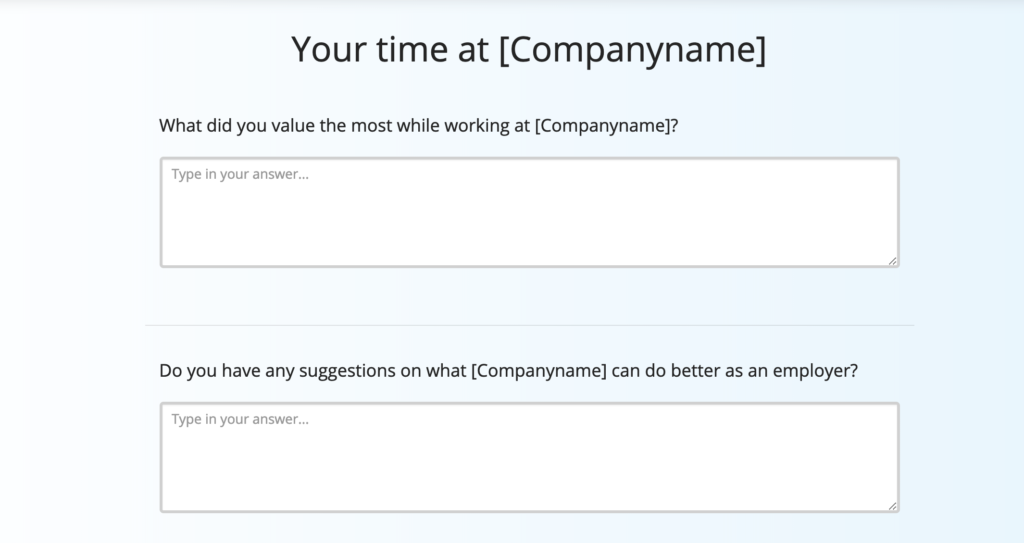Table of Contents
What to ask in an employee exit interview?

Exit interviews have become a standard part of a company’s offboarding process. Just as an employee’s onboarding can set them up for success, a structured offboarding provides HR with information to potentially stem employee turnover.
It might seem counterintuitive to invest time and resources in an employee who is already committed to leaving your company. But a successful employee exit interview helps an organisation identify an issue (through actionable insights) and implement those changes before the problem worsens.
But what should companies be asking in their exit interviews? You don’t want it to turn into a rant session for the employee. Nor do you want the departing employee to hide their honest feedback out of fear that they won’t get a reference in the future.
Honesty
True value from an exit interview comes from honest answers. That’s where an online survey has a major advantage over a face-to-face interview. This removes the risk of any interpersonal friction between the employee and the interviewer. The departing employee can also answer questions at a time convenient for them, and without another person sitting across the desk waiting for a response.
Take the example of Susan, a mid-level executive who has decided to leave Company X. In her exit interview, she notes that at times she felt stifled by her manager and that she lacked the opportunity to think strategically. Then imagine her comments are echoed by other exiting employees in different departments. A fast-thinking organisation can accordingly shift team structures to prevent further departures. Or perhaps Susan received a better overall benefits package from a competitor, which could lead Company X to rethink their salary structure.
The reality is that all employees have a lifespan within a company. Sooner or later, an employee’s journey at your organisation will end. How organisations handle these transitions can make a huge difference in the engagement and performance of your remaining employees.
What questions to ask in the exit interview
You’re looking for valuable insights, and those only come from focused, relevant questions.
Also consider that an exit interview shouldn’t take more than 10 minutes to complete. Even the most patient and generous employee is going to have a limit of how much time they’re willing to commit to reflecting back on their soon-to-be-former employer.
As a general rule of thumb, avoid too many open-ended questions and instead focus on questions that can be rated, which improves data collection.
Matrices can helpful to bunch several questions under one overarching theme. For example, under the banner question “Decision To Leave Company X”, you could include sub-questions such as salary/benefits, leadership, and the physical working environment as influencers.
Add an additional matrix with questions digging deeper into the employee’s time at Company X. Was Susan satisfied with the training and development she received? Did she get the support she needed from her manager?
You can use logic to suss out further details from low scores. If Susan scores a question with a 1 (i.e., not satisfied at all), then a logic to a qualifying question could provide the assessor with valuable information. Another option is to include a open-text box to allow the respondent to qualify their scores.
Invite the departing employee near the end of the survey to make recommendations about how the company can improve certain practices. It’s okay to go beyond the employee’s specific area of expertise. Asking for a bird’s eye view of the organisation can provide keys to innovation or previously missed opportunities. It’s increasingly a best practice to ask a variation on: “Please complete the sentence ‘I don’t know why the company doesn’t just ____”
Feel free to cap the interview with a NPS question (“would you recommend Company X to a friend?). Coupled with perhaps an open-text question about what the company could have done to retain the employee.
Make sure you analyse the feedback you receive
There’s no point to an exit interview if the results will just sit on a desk somewhere. Or perhaps you look at the results but don’t pass them on to senior leadership. But it’s worth it to put in the time and effort to review your exit survey data. Which trends are consistent across positions and departments? What immediately jumps out as an actionable learning that you can apply for existing employees? What are some strengths that could be further emphasized in recruiting new employees?
For HR executives, it’s important to present these findings to the C-suite. Concerned about the level of truth coming from an exit interview? Then feel free to cross-reference them with employee engagement surveys. One isolated case can very well be an outlier, but most trends will show up consistently in surveys from employees throughout the organisation.
-
Netigate Marketing
-
Netigate Marketing
- 4 min read
- .









 Copyright © 2025 Netigate AB, Drottninggatan 25, 111 51, Stockholm, Sverige
Copyright © 2025 Netigate AB, Drottninggatan 25, 111 51, Stockholm, Sverige